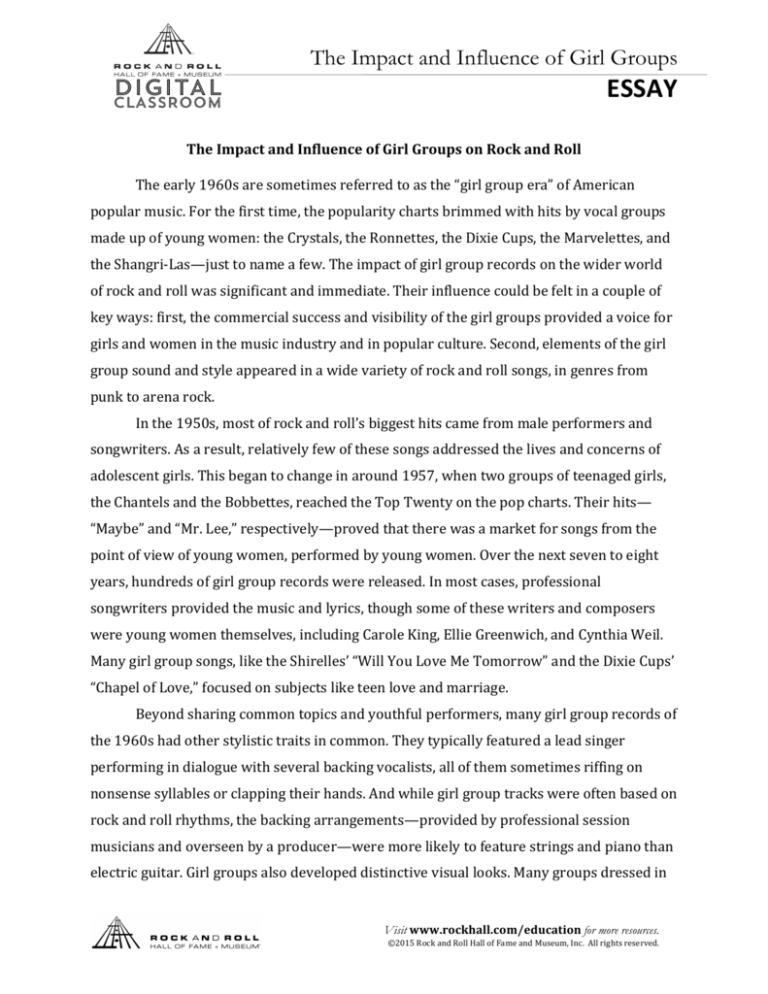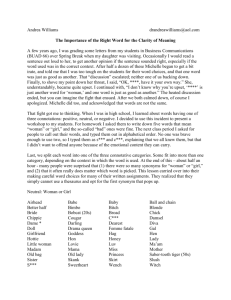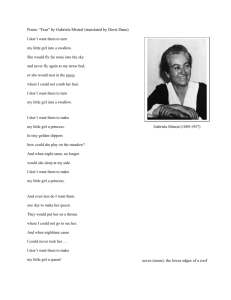
The Impact and Influence of Girl Groups
ESSAY The Impact and Influence of Girl Groups on Rock and Roll The early 1960s are sometimes referred to as the “girl group era” of American popular music. For the first time, the popularity charts brimmed with hits by vocal groups made up of young women: the Crystals, the Ronnettes, the Dixie Cups, the Marvelettes, and the Shangri-­‐Las—just to name a few. The impact of girl group records on the wider world of rock and roll was significant and immediate. Their influence could be felt in a couple of key ways: first, the commercial success and visibility of the girl groups provided a voice for girls and women in the music industry and in popular culture. Second, elements of the girl group sound and style appeared in a wide variety of rock and roll songs, in genres from punk to arena rock. In the 1950s, most of rock and roll’s biggest hits came from male performers and songwriters. As a result, relatively few of these songs addressed the lives and concerns of adolescent girls. This began to change in around 1957, when two groups of teenaged girls, the Chantels and the Bobbettes, reached the Top Twenty on the pop charts. Their hits—
“Maybe” and “Mr. Lee,” respectively—proved that there was a market for songs from the point of view of young women, performed by young women. Over the next seven to eight years, hundreds of girl group records were released. In most cases, professional songwriters provided the music and lyrics, though some of these writers and composers were young women themselves, including Carole King, Ellie Greenwich, and Cynthia Weil. Many girl group songs, like the Shirelles’ “Will You Love Me Tomorrow” and the Dixie Cups’ “Chapel of Love,” focused on subjects like teen love and marriage. Beyond sharing common topics and youthful performers, many girl group records of the 1960s had other stylistic traits in common. They typically featured a lead singer performing in dialogue with several backing vocalists, all of them sometimes riffing on nonsense syllables or clapping their hands. And while girl group tracks were often based on rock and roll rhythms, the backing arrangements—provided by professional session musicians and overseen by a producer—were more likely to feature strings and piano than electric guitar. Girl groups also developed distinctive visual looks. Many groups dressed in Visit www.rockhall.com/education for more resources. ©2015 Rock and Roll Hall of Fame and Museum, Inc. All rights reserved. The Impact and Influence of Girl Groups
matching outfits for performances, and they also carefully choreographed their ESSAY movements. The Ronnettes and the Supremes in particular were considered style icons and were known for their glamorous clothing and hairstyles. The sound of the girl groups was so successful that it wasn’t long before other types of artists began to imitate them. The Beatles, Rolling Stones, and Beach Boys were influenced by the vocal style of the girl groups, and all of them covered girl group hits in the early 1960s. In the 1970s, some glam rock groups incorporated both visual and musical elements of the girl group style. The New York Dolls, for example, loved the music of the Shangri-­‐Las, and even worked with the same producer for a time. Other groups active in the 1970s and 80s—like Blondie, the Go-­‐Gos and the Bangles—mixed the high energy of punk rock with elements of the girl group sound like call-­‐and-­‐response vocals. Solo artists, too, looked to girl groups for inspiration. The backing tracks of songs like Billy Joel’s “Say Goodbye to Hollywood” (1976) or Bruce Springsteen’s “Born to Run” (1975) reflect the influence of the “wall of sound” created by producer Phil Spector on a number of girl group records. In the 1990s, the chart success of several all-­‐female vocal groups including TLC and the Spice Girls reminded many of the early 1960s. Singers like Adele and Amy Winehouse carried the girl group tradition into the twenty-­‐first century by covering 1960s hits and infusing their own songs with stylistic elements drawn from girl group records. Visit www.rockhall.com/education for more resources. ©2015 Rock and Roll Hall of Fame and Museum, Inc. All rights reserved.










